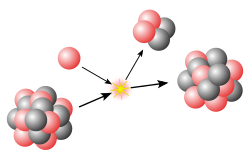| Nuclear physics |
|---|
 |
The interacting boson model (IBM) is a model in nuclear physics in which nucleons (protons or neutrons) pair up, essentially acting as a single particle with boson properties, with integral spin of either 2 (d-boson) or 0 (s-boson). They correspond to a quintuplet and singlet, i.e. 6 states.
Contents
It is sometimes known as the Interacting boson approximation (IBA). [1] : 7
The IBM1/IBM-I model treats both types of nucleons the same and considers only pairs of nucleons coupled to total angular momentum 0 and 2, called respectively, s and d bosons.
The IBM2/IBM-II model treats protons and neutrons separately.
Both models are restricted to nuclei with even numbers of protons and neutrons. [1] : 9

The model can be used to predict vibrational and rotational modes of non-spherical nuclei. [2]